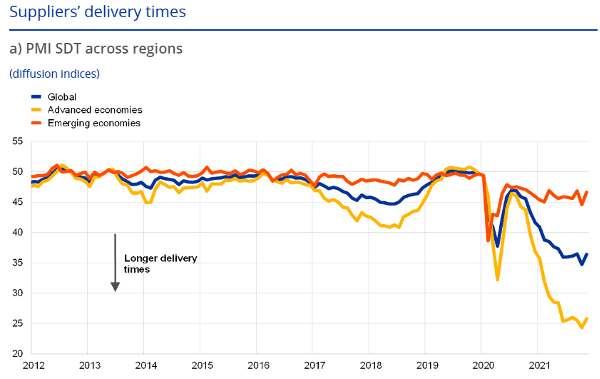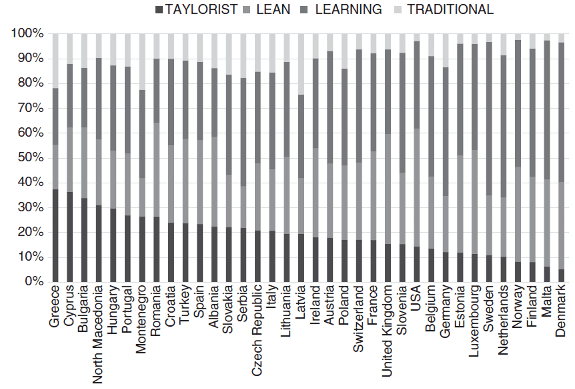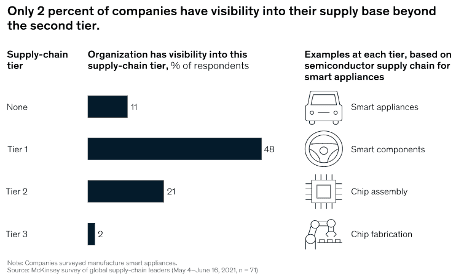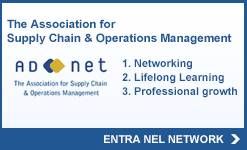News
Inventory Management in Times of disruptions
31/05/2024
Inventory Management in Times of Disruptions
Turns out that many supply chains lack the expected level of resilience and security, a reality demonstrated by significant disruptions caused by recent events such as the COVID-19 pandemic, geopolitical tensions, and climate-related incidents. Regrettably, the vulnerability of our global supply chains is hardly a new revelation, with extensive research conducted prior to the pandemic highlighting this issue in various scholarly databases. In essence, the COVID-19 crisis merely exacerbated existing challenges within our supply networks, rather than unveiling entirely new ones, a perspective asserting a sense of reluctance and complacency that has long influenced decision-making in this domain.
Regrettably, such hesitancy and contentment breeds substantial challenges, as highlighted by reports emphasizing the considerable financial impact of supply chain vulnerabilities. Companies endure significant financial losses and diminished profits, coupled with labour shortage, product scarcity and lengthened supplier delivery times, the latter being one of the most evident manifestation of widespread strains in global production networks. Jaap Bruining, Head of Europe at Coyote Logistics, aptly reflects the severity of these challenges, noting that the pandemic marked the most arduous shipping environment observed by supply chain and logistics professionals in history.

Figure 1 PMI SDT Indicator: Trend of Supplier Delivery Times Adapted from Maria, G. A., Mirco, B., Michele, M., & Luca, M. (2021). Supply chain disruptions and the effects on the global economy. Retrieved from www.ecb.europa.eu.
These disruptions underscore the urgent necessity for businesses to strengthen their resilience against unexpected disturbances. We emphasize the crucial role of contemporary inventory management in mitigating the combined effects of disruptions and meeting operational requirements, such as fulfilling customer demands, minimizing lead times, and adapting to evolving market dynamics.
Looking into the Norm
A prevalent approach in contemporary inventory management is the adoption of just-in-time (JIT) production or the lean production philosophy. This management approach views inventory as waste and aims to minimize it, leading firms to strive to reduce costs related to managing large material purchases and storing excess stocks. And so, businesses opt for placing smaller, more frequent orders from suppliers. Noteworthy JIT implementers include Toyota, the pioneer of lean concepts. Despite substantial supply chain disruptions from the Covid-19 pandemic, Toyota outperformed most competitors, securing the second-highest sales in North America in 2021, trailing only General Motors.
Part of this success, as Chris Nielsen, executive vice president of Toyota North America puts it, is attributed to the Toyota Production System, an analogous term to lean management. The company emphasizes a strategic approach to inventory planning, focusing on three key aspects: optimally sized inventories positioned strategically to buffer demand fluctuations, safety stock to account for disruption risks, and a detailed analysis of lead times. For example, Toyota's assembly facility in Georgetown, Kentucky, embodies lean principles with its just-in-time manufacturing for the seat-installation process, maintaining minimal related inventory. The facility boasts an hourly-based lead time of just a few hours and typically sustains an inventory averaging around two hours. This meticulous inventory management allows Toyota to respond swiftly to changing demands while minimizing excess stock. Other associated merits with JIT approaches include a 9% sales increase and a 7.5% rise in sales per employee.
Such outstanding performance outcomes may elucidate the remarkable popularity of lean inventory management, leading to its widespread adoption across various organizational contexts worldwide. Several comprehensive case studies have underscored the expanding integration of lean principles into workplaces, positioning it as a prevalent method of organizing work in the Americas and Europe alike. Notably, Nordic private and public sector entities have increasingly embraced lean production with the latter’s inclination to these approaches partly driven by the imperative to reduce expenses and modernize operations, spurred by initiatives like New Public Management since the 1990s. Consequently, management approaches like lean, which prioritize rationalization and systems tailored to meet specific objectives, regulations, protocols, and customer demands, hold considerable appeal to organizational leadership.

Figure 2 A Graphical Depiction of Different Work Organisation Types across Countries Adapted from Anttila, T., Oinas, T., & Mustosmäki, A. (2021). Lean in Europe and the USA–A New Dominant Division of Labour? In E. Spangler, The Cambridge International Handbook of Lean Production: Diverging Theories and New Industries around the World (pp. 1-655). Cambridge University Press.
Sceptic Leaners: Questioning Lean Inventory
Despite its allure, certain supply chain experts have attributed challenges and delays encountered in 2020 and 2021 to lean inventory practices. In fact, Toyota's exceptional performance during the pandemic came under scrutiny, with some experts linking the company’s success to a possible departure from its principles of minimal inventories and pull production. Recent studies as well, including those from 2019, indicate a trend toward increasing inventory levels among global companies since the early 2000s. Moreover, earlier research debates or rather questions the effectiveness of lean inventory in enhancing firm performance, citing mixed outcomes among different companies.
The main contention against maintaining a lean supply chain revolves around the argument that low inventory levels lack the necessary buffer to counteract sudden shifts in demand or supply disruptions, such as those witnessed during a global pandemic. Buffers serve to safeguard systems against unforeseen issues. When these buffers are reduced, the supply chain becomes more vulnerable to disruptions occurring anywhere within its network. This vulnerability can render the system "fragile," and only functioning smoothly, until a disruption occurs, potentially leading to system collapse. This prompts consideration of whether the suitability of the lean approach depends on the specific supply chain environment of an organization. Or alternatively, as Shih suggests, it may reflect a lack of understanding regarding certain aspects of a lean approach and their role in enhancing resilience and capacity to manage disruptions.
Inventory Management and Visibility
What a majority of experts agree upon is that the primary objective of inventory management remains clear: maintain just enough inventory to avoid excess costs while preventing stockouts that lead to missed orders or production halts. Achieving this balance is challenging, especially in unpredictable supply chains. However, with the right strategies and technologies, interruptions can be effectively managed, minimizing their impact on inventory levels.
But first and foremost, it is crucial to highlight that lean inventories are seldom the root cause of supply chain disruptions. Additionally, simply increasing inventory levels is unlikely to resolve the issue. Demonstrating that maintaining inventory is more cost-effective than a lean approach is challenging, as excess inventory results in wasted resources like space, labour, materials, and production time. Moreover, determining the appropriate stock levels for crisis situations is inherently uncertain, and there is little financial incentive for companies to maintain excess inventory. Ignoring this fact overlooks the multifaceted nature of supply chain disruptions, which can be influenced by various factors beyond inventory management. Notably, consumer behaviour during crises tends to be unpredictable, leading to erratic fluctuations in demand signals, which can exacerbate issues through the bullwhip effect, regardless of inventory levels.
Inventory Visibility
In light of this argument, the significance of supply chain inventory visibility becomes paramount. Its essence embodies the transformative impact of the Internet on commerce, ushering in a new era of supply chain dynamics. Today, consumers expect round-the-clock access to products, necessitating swift deliveries within hours. Concurrently, businesses are prioritizing these demanding consumers, making it essential for supply chains to maintain and enhance service levels. Therefore, achieving comprehensive visibility and robust IT support throughout the supply chain becomes paramount in managing these complexities. Notably, experts emphasize the escalating importance of visibility for companies venturing into global markets, given the heightened intricacies inherent in such expansions.
By definition, supply chain inventory visibility refers to the capacity of a supply chain platform to furnish users with real-time inventory visibility and insights. This capability equips companies with essential information to enhance the efficiency of their supply chains. It offers up-to-date and precise data on in-stock and in-transit inventory, facilitating optimization of the entire supply chain process. A ubiquitous application includes the use of RFID in enabling item level tracking and tracing.
An Example of increased Inventory Visibility
A prime example illustrating the practicality of inventory visibility is found within the large appliances industry. Faced with the challenge of maintaining visibility over thousands of heavy equipment pieces dispersed across various production plants to enhance inventory tracking and mitigate capital asset losses, one of the leading appliance brands in the U.S. opted for Cloudleaf technology – sensors technologies.
By leveraging Cloudleaf to monitor the real-time condition and whereabouts of these heavy equipment pieces, the company achieved significant improvements. Through continuous collection of location and condition data throughout the supply chain, including indoor areas, yards, and transit routes, the company boasts a comprehensive digital audit trail. This trail accurately tracks the location, condition, and context of capital assets in real time, ensuring precise inventory levels nationwide. The shift from annual physical audits to real-time tracking resulted in substantial cost savings, preventing millions of dollars in annual write-downs attributed to lost or misplaced equipment and tools. Additionally, it provided the company with 100% accurate inventory levels and precise capital asset locations.
The Status Quo is Still Wanting
Nevertheless, despite numerous studies showcasing its manifold advantages, many supply chains still grapple with inadequate inventory visibility. This persistent challenge is indicative of a significant gap between the perceived importance of visibility and its actual implementation in businesses. For example, a survey conducted by the consulting firm 'Supply Chain Insights' underscores this issue, revealing that while 96% of respondents acknowledge the importance of supply chain visibility, only 53% believe their performance in this realm is satisfactory. Similarly, findings from McKinsey & Co. underscore this reluctance, indicating that less than half of surveyed companies have a clear understanding of the location and risks associated with their tier-one suppliers. Moreover, a mere 2% can claim similar insights into suppliers beyond the third tier. This discrepancy is noteworthy as many of today's critical supply shortages, such as those involving semiconductors, often originate from these deeper tiers of the supply chain.
Regrettably, businesses resort to costly measures to address the lack of visibility, such as maintaining excessive safety stock – otherwise referred to as just-in-case inventories – altering transportation methods, or funding expedited deliveries and overtime expenses. Besides, the lack of visibility, whether complete or otherwise, poses a significant challenge for global supply chains, which often involve pipeline inventory valued at billions of dollars.

Figure 3 Inventory Visibility Status
It is therefore essential not to hastily dismiss long standing inventory management methods as obsolete without careful consideration. Rather than discarding them entirely, it is crucial to recognize that recommended approaches aimed at augmenting these existing strategies have not been fully utilized. Therefore, there is significant potential in optimizing these approaches. The question remains: What steps can be taken to leverage these strategies effectively?
Encouraging Adoption of Facilitating Technologies
At the risk of sounding cliché, it is widely acknowledged across various sources that integrating recent technologies into the supply chain system is the most prevalent solution recommended to enhance supply chain inventory visibility. This solution, extensively discussed, primarily revolves around the utilization of inventory management software applications. These applications enable real-time tracking and tracing of inventory at a granular level globally, alerting users to any notable deviations from the planned inventory levels.
Yet, despite this well-known fact, tech adoption surfaces as a significant challenge, with cost being the primary hurdle. An article by Supply Chain Digest reveals that 31% of transportation and logistics professionals surveyed in Germany, 23% in the U.K., and 23% in the U.S. identify cost as the main barrier to further technological implementation. Respondents expressed a desire for reliable solutions that are user-friendly, seamlessly integrated into existing processes and systems, and do not necessitate extensive technical expertise or expensive technology overhauls.
Conclusions
Nonetheless, implementing a technology adoption cost plan can be beneficial. Such a plan can assist in comparing the expenses associated with current practices and equipment to the anticipated costs of adopting new technologies. Additionally, it is imperative for entities within the supply chain to carefully select technologies that align with their specific requirements, rather than opting for a generic, one-size-fits-all approach. Of course, such an approach would necessitate the involvement of technical professionals who can address any compatibility issues that may arise during implementation.
Unfortunately, this hardly marks the end of existing challenges. Other technological adoption hurdles exist when it comes to inventory management. And to effectively navigate these challenges, it is important to have a comprehensive understanding of inventory management systems and how technology can facilitate their efficient and effective implementation.
Supply chain leaders should always keep in mind that before moving to technology adoption and implementation, personnel within the organization should receive proper training and be involved in designing and implementing processes and technologies. The aforementioned steps will create the foundation for an effective and sustainable implementation of a supply chain visibility improvement program.
I corsi APICS, riconosciuti a livello globale, offrono preziose competenze in inventory management e trattano argomenti essenziali come pianificazione, gestione della capacità, controllo delle attività produttive, inventory optimization, performance management e continuous improvement.
I nostri programmi APICS CPIM (Certified in Planning & Inventory Management), CSCP (Certified Supply Chain Professional) e CTSC (Certified in Transformation for Supply Chain), condotti dai nostri Master Instructor, con pluriennale esperienza presso multinazionali, supportano le organizzazioni nei programmi di miglioramento della Supply Chain e ti aiutano a sviluppare competenze state-of-the-art nella gestione della supply chain e delle operations.
Partecipando ai nostri corsi, avrai la possibilità di confrontarti con i leader del settore, acquisire competenze internazionali e ampliare la tua rete professionale. Inoltre, otterrai certificazioni riconosciute a livello globale che dimostreranno la tua competenza e accelereranno il tuo percorso di sviluppo professionale nella gestione della supply chain.
Iscriviti oggi stesso e fai il primo passo verso l'ottimizzazione delle tue strategie di supply chain. Contatta Jessica Mariotti per informazioni sui nostri corsi, classi interaziendali e in-house in Italia e Svizzera, agevolazioni Early Bird e iscrizioni. Email: j.mariotti@advanceschool.org - phone numbers under Contacts
>Nota sugli articoli pubblicati<
Corsi collegati
-
Master APICS CSCP - Certified Supply Chain Professional - Interactive Live Webinar
Il Master CSCP in modalità live webinar è finalizzato a preparare il candidato alla certificazione internazionale Certified Supply Chain Professional (CSCP) di APICS, specifica per l'area Supply Chain Management. » -
Master APICS CTSC - Certified in Transformation for Supply Chain
Questo programma è volto a preparare i candidati per la certificazione internazionale APICS CTSC (Certified in Trasformation for Supply Chain) » -
Technology Certificate - APICS
Il corso state-of-the-art di ASCM/APICS per trasferire le conoscenze sulle ultime tecnologie - per esempio Blockchain, Advanced Analytics, 3D Manufacturing - e di come applicarle nella Supply Chain. Al termine del percorso, verrà rilasciato il SC Techonology Certificate di ASCM. »








